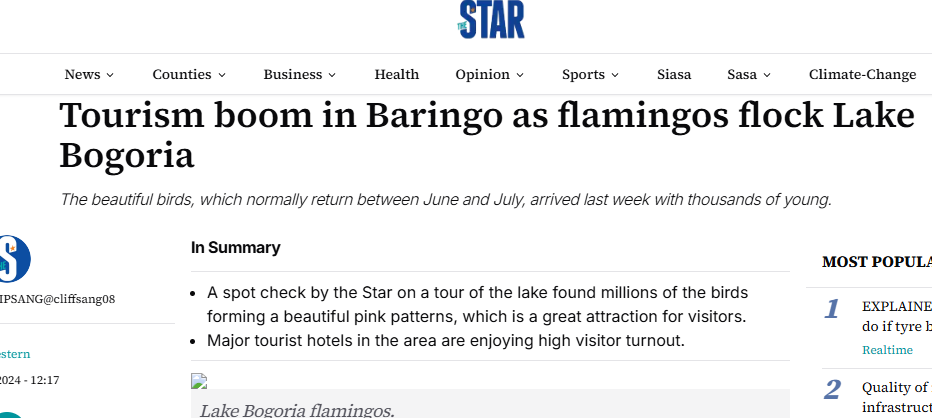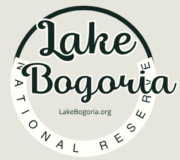Lake Bogoria National Park, nestled in Kenya’s picturesque Great Rift Valley, is famed worldwide for its spectacular flamingo populations. Each year, tens of thousands of these vibrant birds converge here, turning the shores of the lake into an awe-inspiring pink panorama. Here’s your complete guide to experiencing this extraordinary natural phenomenon.
In July 2024, Citizen TV’s Jeff Koinange described the flamingos flocking to Lake Bogoria as “flying gold,” vital for sustaining tourism in the area. Tourism had previously suffered due to drought, but the 2024 season marked a significant turnaround.

Panda.org and the Star Newspaper also highlighted this revival with an article titled “Tourism boom in Baringo as flamingos flock Lake Bogoria,” attributing the increased flamingo presence to a successful breeding season at Lake Natron in Tanzania.
The birds, which typically arrive between June and July, reached Lake Bogoria between the last week of June and the first week of July 2024, bringing thousands of juvenile flamingos. A similar pattern is anticipated for the 2025 season.
Witness the Stunning Flamingo Migration at Lake Bogoria
Lake Bogoria serves as a primary feeding ground for flamingos due to its abundant blue-green algae (cyanobacteria), a favorite food source for these birds. As seasonal shifts alter water conditions and food availability in other Rift Valley lakes, flamingos migrate in massive numbers to Bogoria, transforming its landscape into a living pink canvas. Witnessing this migration is an unforgettable experience that nature lovers and photographers alike treasure.
Lake Bogoria now hosts larger flamingo populations compared to Lake Nakuru, where numbers have declined due to pollution and rising water levels. A recent report also recommended including other critical flamingo habitats, like Lake Natron and various lakes in Tanzania and Ethiopia, as World Heritage Sites to ensure continued protection of these vital ecosystems.
Read about fleeing flamingos in Lake Nakuru.
Best Time to See Flamingos at Lake Bogoria
The ideal time for flamingo viewing at Lake Bogoria generally falls between late August and early October. During these months, the flamingo population reaches its peak, ensuring visitors are treated to the fullest spectacle. Early mornings (between 6:00 am and 8:00 am) and late afternoons (from 4:00 pm until sunset) offer the best chances for dramatic lighting and active flamingo behaviors.
Tips for Photographing Flamingos at Lake Bogoria
Capturing stunning flamingo images at Lake Bogoria requires some preparation:
- Optimal Timing: Photograph flamingos during the golden hours shortly after sunrise or just before sunset for ideal lighting conditions.
- Use the Right Equipment: A telephoto lens (300mm or greater) is essential for capturing detailed close-up shots without disturbing the flamingos.
- Steady Shots: Use a tripod or monopod for stable, sharp images, particularly in low light.
- Creative Composition: Look for reflections, group interactions, and flock movements to create dynamic compositions.
- Patience: Allow yourself enough time to quietly observe flamingo behavior, such as feeding rituals, flight, or mating dances, to get unique and impactful images.
Fascinating Facts About Flamingos at Lake Bogoria
- Colorful Diet: Flamingos’ distinctive pink feathers result from pigments (carotenoids) in the algae they consume at Lake Bogoria.
- Highly Social Birds: Flamingos flock in massive groups, sometimes numbering tens of thousands, making for extraordinary sights.
- Efficient Feeders: Their specially adapted beaks filter tiny algae and organisms from alkaline waters, essential for their survival.
- Synchronised Breeding: Flamingos often breed in large, synchronized colonies, constructing mud nests to raise their young safely away from predators.
- Migratory Behavior: Flamingos constantly shift between Rift Valley lakes in response to changing water conditions and food supplies, making Bogoria a critical stop.
Book Your Flamingo Tour at Lake Bogoria
Booking a guided flamingo tour at Lake Bogoria is highly recommended for visitors seeking an immersive experience. Tours led by knowledgeable local guides offer valuable insights into flamingo behavior, ecology, conservation efforts, and local cultural stories. Tours typically include visits to prime viewing locations and can be tailored specifically to bird enthusiasts, photographers, or casual wildlife observers.
Top Flamingo Viewing Spots at Lake Bogoria
To enjoy the best flamingo sightings, consider these premier locations within Lake Bogoria National Park:
- Fig Tree Camp Area: A popular spot due to close proximity to large flamingo gatherings, excellent for photography.
- Lake Bogoria Hot Springs: Here, flamingos gather near geothermal hot springs, providing unique opportunities for spectacular and surreal photography.
- Southern Shoreline: Offers quieter and less crowded viewing opportunities, ideal for photography and peaceful observation.
- Eastern Shore Viewing Points: Excellent at sunrise, providing beautiful lighting for photography and clear views of flamingo activities.
Frequently Asked Questions (FAQs) about Lake Bogoria Flamingos
1. Are flamingos at Lake Bogoria present all year round?
While flamingos can usually be found at Lake Bogoria throughout the year, their numbers vary significantly. Peak seasons occur between late August and early October. Outside these months, smaller flocks may still be present but in reduced numbers.
2. How close can visitors get to the flamingos at Lake Bogoria?
Visitors are advised to maintain a respectful distance of at least 20-30 meters to avoid disturbing the birds. Using binoculars or zoom lenses is recommended for close viewing.
3. Can I fly drones for aerial views of flamingos at Lake Bogoria?
Drone usage is strictly regulated and typically prohibited within the national park to protect wildlife from disturbance. Always seek permission from Kenya Wildlife Service (KWS) before considering drone photography.
4. Are there flamingo species other than the lesser flamingo at Lake Bogoria?
Lake Bogoria primarily hosts lesser flamingos, though greater flamingos can occasionally be spotted. Lesser flamingos are smaller, brighter pink, and feed mainly on algae.
5. Do flamingos breed at Lake Bogoria National Park?
Flamingos rarely breed at Lake Bogoria. Instead, the lake primarily serves as a feeding site. Flamingo breeding usually occurs at other Rift Valley locations like Lake Natron in Tanzania.
6. Are there health risks associated with visiting flamingos at Lake Bogoria?
Generally, no. However, visitors should follow basic health precautions, such as using insect repellent and not swimming in the alkaline waters, to avoid skin irritation.
7. Is there accommodation within the park specifically for flamingo viewing?
While no accommodation is exclusively dedicated to flamingo viewing, lodges and camps near Lake Bogoria, such as Lake Bogoria Spa Resort or Fig Tree Camp, offer excellent accessibility to prime flamingo locations.
8. Are flamingo numbers affected by environmental factors at Lake Bogoria?
Yes, flamingo populations fluctuate based on environmental factors such as water levels, algae availability, and weather conditions. Heavy rains or drought can dramatically impact flamingo numbers.
9. Are there entry fees specifically for viewing flamingos at Lake Bogoria?
No additional fees are required specifically for flamingo viewing. Visitors pay standard park entry fees managed by Kenya Wildlife Service.
10. Is Lake Bogoria wheelchair-accessible for flamingo viewing?
Accessibility is limited due to uneven terrain, but certain spots, like viewpoints near the park entrance, provide more accessible viewing areas. Visitors with mobility challenges should contact park officials in advance for assistance.
11. Why do flamingos choose Lake Bogoria over other Rift Valley lakes?
Flamingos prefer Lake Bogoria because its alkaline waters foster abundant growth of their primary food—cyanobacteria (blue-green algae). Other lakes fluctuate more drastically in food availability, driving flamingos to Bogoria during critical migration periods.
12. Can I feed the flamingos at Lake Bogoria?
No. Feeding wildlife, including flamingos, is strictly prohibited as it can disrupt their natural feeding habits, cause health problems, and negatively impact their survival.
13. Do flamingos at Lake Bogoria migrate internationally?
Flamingos primarily migrate regionally within the East African Rift Valley lakes—between Kenya, Tanzania, Ethiopia, and Uganda—but they generally do not migrate internationally outside East Africa.
14. Are flamingos at Lake Bogoria endangered?
Lesser flamingos, the primary species at Lake Bogoria, are listed as “Near Threatened.” They face threats such as habitat degradation, water pollution, and changes in water levels impacting their food sources.
15. Is there a visitor limit for viewing flamingos at Lake Bogoria?
There isn’t a specific visitor limit for flamingo viewing; however, park officials sometimes regulate visitor numbers at sensitive areas during peak seasons to minimize ecological impact and disturbance.
16. Do flamingos at Lake Bogoria have natural predators?
Yes. Flamingos at Lake Bogoria are occasionally preyed upon by predators such as eagles, marabou storks, hyenas, jackals, and baboons, particularly targeting young or injured birds.
17. Can flamingos at Lake Bogoria survive in freshwater lakes?
Flamingos strongly prefer alkaline or saline lakes because the algae they consume thrive in such environments. Freshwater lakes lack the specific algae species necessary for their diet, making them unsuitable for flamingo survival.
18. Can flamingos swim or dive in Lake Bogoria?
Flamingos at Lake Bogoria do not typically swim or dive deeply but instead wade through shallow water, using their specialized bills to filter food near the water’s surface.
19. How many flamingos can Lake Bogoria host at its peak?
Lake Bogoria has hosted up to two million flamingos during peak migration seasons, although typical numbers often range between several hundred thousand and a million birds at any given time.
20. Is camping permitted for overnight flamingo viewing at Lake Bogoria?
Camping is permitted in designated areas within Lake Bogoria National Park, providing visitors the opportunity to experience flamingos at sunrise or sunset. Visitors should confirm specific camping sites with park management prior to arrival.
21. Are there educational resources or visitor centers focused on flamingos at Lake Bogoria?
Yes, the Lake Bogoria Visitor Center provides educational displays about flamingos, their ecology, migratory patterns, and conservation efforts, offering valuable insights for visitors.
22. What should I wear when visiting flamingos at Lake Bogoria?
Wear comfortable, breathable clothing in neutral or muted colors, sturdy walking shoes, and a hat. Sunscreen, sunglasses, and insect repellent are also recommended due to the sunny, open environment.
23. Can I volunteer or support flamingo conservation efforts at Lake Bogoria?
Yes, various local conservation groups and initiatives offer volunteer opportunities and accept donations to support flamingo research, habitat protection, and educational outreach. Contact park authorities or local NGOs for more information.
24. Is flash photography allowed when photographing flamingos at Lake Bogoria?
No. Flash photography is discouraged as it can disturb and stress wildlife. Natural lighting, particularly during early mornings and evenings, is ideal for photographing flamingos.
25. How long do flamingos stay at Lake Bogoria before moving to other lakes?
Flamingos typically remain at Lake Bogoria for several weeks to a few months, depending on food availability, rainfall patterns, and regional conditions in other Rift Valley lakes.
26. How does climate change affect flamingos at Lake Bogoria?
Climate change impacts flamingos at Lake Bogoria by altering rainfall patterns, affecting water levels and algae growth, thereby influencing flamingo migration patterns, feeding opportunities, and long-term population health.
27. Can flamingos fly long distances between lakes?
Yes, flamingos are capable of flying significant distances between Rift Valley lakes, often traveling hundreds of kilometers to follow food sources and suitable breeding grounds.
28. How can visitors minimize their environmental impact when viewing flamingos?
Visitors should stay on designated paths, avoid disturbing wildlife, dispose of all waste properly, avoid loud noises, and strictly follow park guidelines to protect flamingo habitats.
29. Do flamingos at Lake Bogoria interact with other bird species?
Yes, flamingos at Lake Bogoria share their habitat with various other bird species, including pelicans, herons, storks, and cormorants, although direct interactions are minimal as flamingos typically keep to their own large flocks.
30. Are there guided night visits to see flamingos at Lake Bogoria?
Night visits to see flamingos are uncommon due to safety concerns and limited visibility. However, early morning guided tours beginning just before sunrise offer an excellent alternative.
